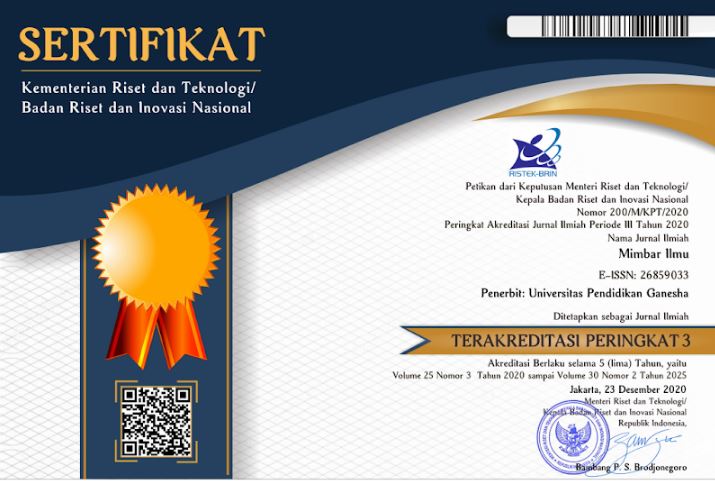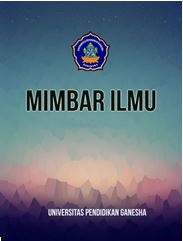*) MIMBAR ILMU is Accredited by The Ministry of Research, Technology, and Higher Education of the Republic of Indonesia, which is ranked SINTA 2
Tentang Jurnal Ini
Focus and Scope
As an international, multi-disciplinary, peer-refereed journal, the scope of this journal is in learning and instruction area which provides a platform for the publication of the most advanced scientific researches in the areas of learning, development, instruction and teaching at elementary school. The journal welcomes original empirical investigation. The papers may represent a variety of theoretical perspectives and different methodological approaches. They may refer to any age level, from infants to adults and to a diversity of learning and instructional settings, from laboratory experiments to field studies. The major criteria in review and the selection process concerns the significance of the contribution to the area of learning and instruction. Instruction, learning and teaching, curriculum development, learning environment, teacher education, educational, technology, and educational development at elementary school.
Peer Review Process
This journal operates a conventional single-blind reviewing policy in which the reviewer's name is always concealed from the submitting author. Authors should present their papers honestly without fabrication, falsification, plagiarism or inappropriate data manipulation. Submitted papers are evaluated by anonymous referees for contribution, originality, relevance, and presentation. Papers will be sent for anonymous review by at least two reviewers who will either be members of the Editorial Board or others of similar standing in the field. In order to shorten the review process and respond quickly to authors, the Editors may triage a submission and come to a decision without sending the paper for external review. The Editor shall inform you of the results of the review as soon as possible, hopefully in 8 weeks. The Editors’ decision is final and no correspondence can be entered into concerning manuscripts considered unsuitable for publication in this ournal. All correspondence, including notification of the Editors’ decision and requests for revisions, will be sent by email.
Publication Frequency
Mimbar Ilmu is published twice a year (issued in April, July and October).
Open Access Policy
This journal is an open-access journal that provides immediate, worldwide, barrier-free access to the full text of all published articles without charge readers or their institutions for access. Readers have the right to read, download, copy, distribute, print, search, or link to the full texts of all articles in Mimbar Ilmu. This journal provides immediate open access to its content on the principle that making research freely available to the public supports a greater global exchange of knowledge.
Publication Ethics
Our Publication Ethics are based on COPE’s Best Practice Guidelines for Journal Editors.
Duties of Authors
Reporting Standards:
Authors should present an accurate account of the original research performed as well as an objective discussion of its significance. Researchers should present their results honestly and without fabrication, falsification or inappropriate data manipulation. A manuscript should contain sufficient detail and references to permit others to replicate the work. Fraudulent or knowingly inaccurate statements constitute unethical behavior and are unacceptable. Manuscripts should follow the submission guidelines of the journal.
Originality and Plagiarism:
Authors must ensure that they have written entirely original work. The manuscript should not be submitted concurrently to more than one publication unless the editors have agreed to co-publication. Relevant previous work and publications, both by other researchers and the authors’ own, should be properly acknowledged and referenced. The primary literature should be cited where possible. Original wording taken directly from publications by other researchers should appear in quotation marks with the appropriate citations.
Multiple, Redundant, or Concurrent Publications:
An author should not in general publish manuscripts describing essentially the same research in more than one journal or primary publication. Submitting the same manuscript to more than one journal concurrently constitutes unethical publishing behavior and is unacceptable.
Acknowledgement of Sources:
Proper acknowledgment of the work of others must always be given. Authors should cite publications that have been influential in determining the nature of the reported work.
Authorship of the Paper:
Authorship should be limited to those who have made a significant contribution to the conception, design, execution, or interpretation of the reported study. All those who have made significant contributions should be listed as co-authors. Where there are others who have participated in certain substantive aspects of the research project, they should be acknowledged or listed as contributors.
The corresponding author should ensure that all appropriate co-authors and no inappropriate co-authors are included on the paper, and that all co-authors have seen and approved the final version of the paper and have agreed to its submission for publication.
Disclosure and Conflicts of Interest:
All authors should disclose in their manuscript any financial or other substantive conflict of interest that might be construed to influence the results or interpretation of their manuscript. All sources of financial support for the project should be disclosed.
Fundamental Errors in Published Works:
When an author discovers a significant error or inaccuracy in his/her own published work, it is the author’s obligation to promptly notify the journal editor or publisher and cooperate with the editor to retract or correct the paper.
Hazards and Human or Animal Subjects:
The author should clearly identify in the manuscript if the work involves chemicals, procedures or equipment that have any unusual hazards inherent in their use.
Duties of Editor
Publication Decisions:
Based on the review report of the editorial board, the editor can accept, reject, or request modifications to the manuscript. The validation of the work in question and its importance to researchers and readers must always drive such decisions. The editors may be guided by the policies of the journal's editorial board and constrained by such legal requirements as shall then be in force regarding libel, copyright infringement and plagiarism. The editors may confer with other editors or reviewers in making this decision. Editors have to take responsibility for everything they publish and should have procedures and policies in place to ensure the quality of the material they publish and maintain the integrity of the published record.
Confidentiality:
The editor and any editorial staff must not disclose any information about a submitted manuscript to anyone other than the corresponding author, reviewers, potential reviewers, other editorial advisers, and the publisher, as appropriate.
Review of Manuscripts:
Editor must ensure that each manuscript is initially evaluated by the editor for originality. The editor should organize and use peer review fairly and wisely. Editors should explain their peer review processes in the information for authors and also indicate which parts of the journal are peer reviewed. Editor should use appropriate peer reviewers for papers that are considered for publication by selecting people with sufficient expertise and avoiding those with conflicts of interest.
Fair Play:
The editor must ensure that each manuscript received by the journal is reviewed for its intellectual content without regard to sex, gender, race, religion, citizenship, etc. of the authors. An important part of the responsibility to make fair and unbiased decisions is the upholding of the principle of editorial independence and integrity. Editors are in a powerful position by making decisions on publications, which makes it very important that this process is as fair and unbiased as possible.
Confidentiality:
The editor must ensure that information regarding manuscripts submitted by the authors is kept confidential. Editors should critically assess any potential breaches of data protection and patient confidentiality. This includes requiring properly informed consent for the actual research presented, consent for publication where applicable.
Disclosure and Conflicts of Interest:
The editor of the Journal will not use unpublished materials disclosed in a submitted manuscript for his own research without written consent of the author. Editors should not be involved in decisions about papers in which they have a conflict of interest
Duties of Reviewers
Contribution to Editorial Decisions:
Peer review assists the editor in making editorial decisions and through the editorial communications with the author may also assist the author in improving the paper.
Confidentiality:
Information regarding manuscripts submitted by authors should be kept confidential and be treated as privileged information. They must not be shown to or discussed with others except as authorized by the editor.
Acknowledgement of Sources:
Reviewers must ensure that authors have acknowledged all sources of data used in the research. Reviewers should identify relevant published work that has not been cited by the authors. Any statement that an observation, derivation, or argument had been previously reported should be accompanied by the relevant citation. The reviewers should notify the journal immediately if they come across any irregularities, have concerns about ethical aspects of the work, are aware of substantial similarity between the manuscript and a concurrent submission to another journal or a published article, or suspect that misconduct may have occurred during either the research or the writing and submission of the manuscript; reviewers should, however, keep their concerns confidential and not personally investigate further unless the journal asks for further information or advice.
Standards of Objectivity:
Review of submitted manuscripts must be done objectively and the reviewers should express their views clearly with supporting arguments. The reviewers should follow journals’ instructions on the specific feedback that is required of them and, unless there are good reasons not to. The reviewers should be constructive in their reviews and provide feedback that will help the authors to improve their manuscript. The reviewer should make clear which suggested additional investigations are essential to support claims made in the manuscript under consideration and which will just strengthen or extend the work
Disclosure and Conflict of Interest:
Privileged information or ideas obtained through peer review must be kept confidential and not used for personal advantage. Reviewers should not consider manuscripts in which they have conflicts of interest resulting from competitive, collaborative, or other relationships or connections with any of the authors, companies, or institutions connected to the papers. In the case of double-blind review, if they suspect the identity of the author(s) notify the journal if this knowledge raises any potential conflict of interest.
Promptness:
The reviewers should respond in a reasonable time-frame. The reviewers only agree to review a manuscript if they are fairly confident they can return a review within the proposed or mutually agreed time-frame, informing the journal promptly if they require an extension. In the event that a reviewer feels it is not possible for him/her to complete review of manuscript within stipulated time then this information must be communicated to the editor, so that the manuscript could be sent to another reviewer.
Review Guidelines
Presentation
- The background of the study;
- State of the art, relevant research to justify the novelty of the manuscript;
- Gap analysis, novelty statement;
- Hypothesis or problem statement (optional);
- Approach to resolve the problem; and
- The aim of the study.
- The method is written clearly, so then other researchers can replicate the experiment or research with the same result;
- Not only describe the definition of terms but also describe how to conduct the research;
- Describe the location, participant, research instrument, and data analysis;
- The data presented has been processed (not raw data) into a table or figure and given a supportive description which easy to follow.
- The result related to the original questions or objectives outlined in the Introduction section.
- The author describes the result of the study consistent with what other investigators have reported or there any differences.
- The author provides interpretation scientifically for each of the results or findings presented.
- The author describes the implications of the research.
- The author describes the limitations of the research or drawbacks to the method or position.
- The author describes further need/areas for research or expansion of ideas.
- Answer the objectives of the research;
- Implication or recommendation (optional);
- Written in a paragraph, not in bullet/numbering.
Screening for Plagiarism
Papers submitted to Mimbar Ilmu will be screened for plagiarism using Turnitin plagiarism detection tools. Mimbar Ilmu will immediately reject papers leading to plagiarism or self-plagiarism. Before submitting articles to reviewers, those are first checked for similarity/plagiarism tool, by a member of the editorial team. The papers submitted to the Mimbar Ilmu must have a similarity level of less than 20% (Exclude Bibliography), and the similarity score to each source is no more than 3%.
Plagiarism is the exposure of another person’s thoughts or words as though they were your own, without permission, credit, or acknowledgment, or because of failing to cite the sources properly. Plagiarism can take diverse forms, from literal copying to paraphrasing the work of another. To accurately judge whether an author has plagiarized, we emphasize the following possible situations:
- An author can literally copy another author’s work- by copying word by word, in whole or in part, without permission, acknowledge or citing the original source. This practice can be identified by comparing the original source and the manuscript/work who is suspected of plagiarism.
- Substantial copying implies an author to reproduce a substantial part of another author, without permission, acknowledge, or citation. The substantial term can be understood both in terms of quality as quantity, being often used in the context of Intellectual property. Quality refers to the relative value of the copied text in proportion to the work as a whole.
- Paraphrasing involves taking ideas, words, or phrases from a source and crafting them into new sentences within the writing. This practice becomes unethical when the author does not properly cite or does not acknowledge the original work/author. This form of plagiarism is the more difficult form to be identified.








